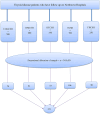Drug related problems and associated factors among thyroid disorder patients in Northwest Ethiopia
- PMID: 40715434
- PMCID: PMC12297595
- DOI: 10.1038/s41598-025-86293-4
Drug related problems and associated factors among thyroid disorder patients in Northwest Ethiopia
Abstract
Thyroid disorder patients are likely to have a prescription for various categories of drugs including those with a narrow therapeutic index and others, which affects thyroid function. However, information regarding drug therapy problems in thyroid patients has not been studied here yet. Thus this study aimed to assess drug therapy problems and associated factors among thyroid disorder patients, who had follow-ups at Northwest Hospitals of Ethiopia. A multicenter hospital-based cross-sectional study design was employed through patient interviews and chart review at public hospitals in Northwest Ethiopia. A simple random sampling technique was used to recruit patients for interviews. The identified drug-related problem was recorded and classified using Cipolle et al. 2012, adverse drug reactions were assessed by using the Naranjo algorithm of adverse drug reaction probability scale, and Up-to-date was used for the drug-drug interaction checker. The collected data was cleared, entered into epidata, checked for correctness, and exported to STATA version 17 for analysis. The results were summarized using descriptive statistics including frequency, mean, median, and standard deviation. Logistic regression analysis was conducted to identify the independent predictors of drug therapy problems. A P-value < 0.05 is considered statistically significant. Among 351 study participants most of them 300 (85.47%) were females. The study participants' mean (± SD) age was 45.1± (0.74) years. At least one drug-related problem was recorded from 60.11%, (95% CI: 54.9-65.13) of study participants with a mean of 1.54 ± 0.046 drug-related problems per patient. The most common drug-related problems were non-adherence (34.47%) followed by adverse drug reactions (17.2%) and ineffective drug therapy (8.2%). Factors independently associated with drug-related problems were age [AOR = 2.85, 95%CI: (1.05-7.69), P-value = 0.039], poly-pharmacy [AOR = 2.57, 95%CI: (1.01-6.29), P-value = 0.046], comorbidity [AOR = 2.09, 95%CI: (1.07-4.05), P-value = 0.030], and purchasing medication from private pharmacy [AOR = 2.62, 95%CI: (1.06-6.49), P-value = 0.038]. The prevalence of drug-related problems among adult thyroid disease patients who had follow up at ambulatory clinics was very high. Age, poly-pharmacy, comorbidity, and purchasing medication in private pharmacies were independent predictors of drug-related problems. The most commonly involved medication class in experiencing drug-related problems was thionamides.
Keywords: Drug-related problems; Ethiopia; Patient safety; Risk factors; Thyroid disorders.
© 2025. The Author(s).
Conflict of interest statement
Declarations. Competing interests: The authors declare no competing interests. Ethical approval: The study was ethically approved by the institutional review board of the University of Gondar with reference number 122/2014. This study was done complying with the declaration of Helsinki. Participants gave informed consent to participate in the study before taking part. Then, permission was confirmed from the selected hospitals to proceed with the study. Participants were asked for written forms after the objectives of the study were briefed. They were conditioned to give consent, and after accessing it they were interviewed.
Figures
Similar articles
-
Work-related musculoskeletal disorders and associated factors among hospital sanitary workers in public hospitals of Eastern Ethiopia.BMC Musculoskelet Disord. 2025 Jul 4;26(1):640. doi: 10.1186/s12891-025-08873-9. BMC Musculoskelet Disord. 2025. PMID: 40616057 Free PMC article.
-
Prevalence and predictors of non-medical and lifetime use of controlled drugs among patients accessing mental health services at the university of Gondar comprehensive specialized hospital: Northwest Ethiopia.BMC Psychiatry. 2025 Jul 1;25(1):638. doi: 10.1186/s12888-025-07092-9. BMC Psychiatry. 2025. PMID: 40597836 Free PMC article.
-
Non-prescribed drug use and its associated factors among pregnant women in Southwest Ethiopia.Sci Rep. 2025 Jul 2;15(1):22851. doi: 10.1038/s41598-024-80247-y. Sci Rep. 2025. PMID: 40595740 Free PMC article.
-
Drugs for preventing postoperative nausea and vomiting in adults after general anaesthesia: a network meta-analysis.Cochrane Database Syst Rev. 2020 Oct 19;10(10):CD012859. doi: 10.1002/14651858.CD012859.pub2. Cochrane Database Syst Rev. 2020. PMID: 33075160 Free PMC article.
-
Signs and symptoms to determine if a patient presenting in primary care or hospital outpatient settings has COVID-19.Cochrane Database Syst Rev. 2022 May 20;5(5):CD013665. doi: 10.1002/14651858.CD013665.pub3. Cochrane Database Syst Rev. 2022. PMID: 35593186 Free PMC article.
References
-
- Khan, A. Thyroid disorders, ethiology and prevalence Journal of medical sciences. (2002).
-
- Toyib, S., Kabeta, T., Dendir, G., Bariso, M. & Reta, W. Prevalence, clinical presentation and patterns of thyroid disorders among anterior neck mass patients visiting Jimma Medical Center, Southwest Ethiopia. Biomed. J. Sci. Tech. Res.18 (2), 13431–13435 (2019).
-
- Krotkiewski, M. J. Thyroid hormones in the pathogenesis and treatment of obesity. Eur. J. Op. 440(2–3), 85–98 (2002). - PubMed
-
- Europe, P. C. N. PCNE Classification for drug-related problems V5. 01. (2017).
Publication types
MeSH terms
LinkOut - more resources
Full Text Sources
Medical


